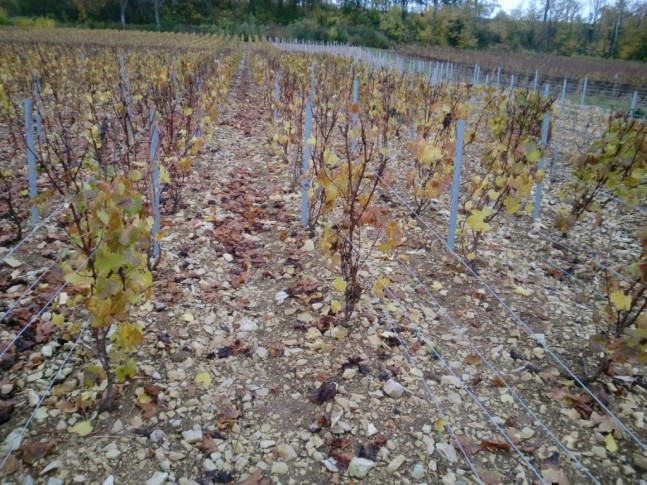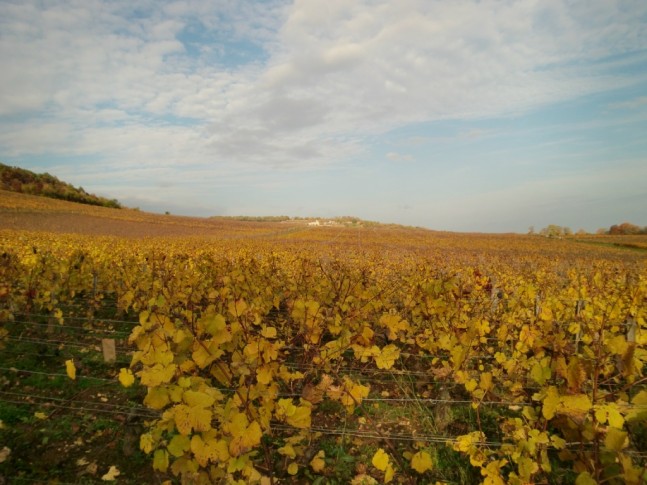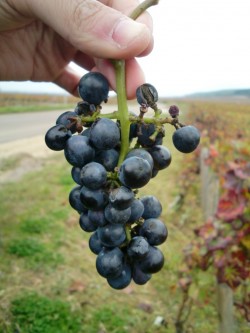Our intrepid Singapore Sommelier, Shalom Chin, travels in Burgundy is coming to the end and he shares his thoughts and summary on the communes of Burgundy. He heads to Provence next, and will sending in regular reports on his travels through the region.
Part 8 of the Series. General Thoughts on the communes
You are going to hear me say this many times in my travels. It is tragic to say that there are always unquantifiable amounts of knowledge learned in these trips to wine regions that I would love to share. However, not everything gleaned can always be written about in so little time and space. If there is one thing I learned about writing about wine regions, it is leave out information that is readily available and write about what people are not commonly aware of.
There are many things I have yet to get into details with Burgundy such as the winemaking methods, Chablis, my visit to Côte Chalonnaise, tasting the legendary vineyard that Henri Jayer made famous and the looking at the marc of Domaine Romanée Conti. I have been very fortunate to experience these things. Again, you will hear me say, “Perhaps another time, I will get to that.” That is if the next adventure does not distract me.
To close the chapter on Burgundy, I have decided to share some tips on choosing a wine from Burgundy especially if you are uninitiated. I have broken down different styles of Burgundy in a very general way so that even if you have not tasted the bottle, by looking at the name of the commune, you can make an educated guess what it will be like.
I have formulated this based on blind-tasting each bottle side by side to narrow down styles and flavours. There are just too many communes to list them all but I have tried to include as many as I can.
From North to South, they are:
Chablis
Grand Crus – There are seven Grand Crus in Chablis which are Bougros, Les Preuses, Vaudésir, Grenouilles, Valmur, Les Clos, and Blanchots. I cannot say which Grand Cru is the best as I have yet to taste Grenouillesand Valmur but I must say I have not tasted an interesting Bougros yet. Still, you will generally find Grand Cru Chablis to contain that beautiful mineral, white flower, light honey and elegant nose that you cannot miss unless you are suffering from anosmia. The complexity on the palate and the flavour of saffron can sometimes be identified after a day of opening.
Premier Crus – 1er Crus can be complex depending on the vineyard and the producer. In France it is not very expensive to purchase a 1er cru wine around €12 but try this in Asia, and it can be a costly experiment. Aromas can be like Grand Crus with less concentration and expressiveness but still can contain complexity. Minerality is usually present and some of those lovely saffron aromas can also be found after the first day of opening.
Petit Chablis and Chablis AOC–I find most normal Chablis to have that leesy, green apple smell to it that can still have some greenness to it but with a zinginess on the palate.
Côte de Nuits
Marsannay – This is one of those late-bloomer red wine communes that have yet to prove itself to the world. I find some Marsannays to be expressive with a complexity of forest floor and compost. It can be very complex with the nose changing every few minutes. Good ones are earthy on the palate with great wood, fruit and spice balance.
Fixin – A neighbor of Masannay, this red wine commune can be earthy and slightly barnyard accompanied by strawberries but lacking the same expressiveness in good Marsanny.
Gevrey Chambertin – Red Gevrey is a heavyweight style that can potentially be aromatic and similar in profile as Nuits-St-Georges with the plums and cassis aromas. The better styles are better integrated with oak and has a dark, brooding character to it with black pepper, leather, and spices. On the palate, the tannins are high and the structure is quite solid.
Morey-Saint-Denis – The reds are smoky, cherries, and a sort of lollied red apple aroma to it. It has similarities to Savigny-les-Beaune. People don’t talk much about MSD whites but I find them very delicious with a sort of polishness to it and light cinnamon spice accompanied by mandarins. The palate can be toastier than your Montrachets.
Chambolle Musigny –Probably the most feminine out of all the Côte de Nuits and in my top 5 reds. Expensive ones can be very complex with aromas of rose and jasmine. This is a hard wine to describe because it smells like terrior. Everything about it is subtle. The flavours too can be complex, with a vibrant acid and earthiness/mushroom flavor to it. This is one of those wines that can drink by itself or is well adapted to food like terrine. A very classy wine if you can get your hands on good ones which are usually expensive.
Vougeot – Good red Vougeot is under-rated. This is one of those wines that can achieve intense fruit sweetness on the nose, cassis, herbs, coffee if there is oak and sometimes graphite smells. The texture for Grand Cru can be powdery and in good years or producers, there can be enough concentration to displays flavours of licorice.
Vosne-Romanée – Out of all the communes, this is probably my list of top 5 red wine communes. Distinctly different from the rest and easy to pick out blind from the power and concentration. Violets, plums and cherry spice are some of the aromas one can expect. Power and elegant, this is a wine with slightly higher ripeness and alcohol than other communes.
Nuits-Saint-Georges – NSG produces red wines that have rough tannins and a heavy nose with lots of dark cherry and blackcurrant fruit when opened young. Like Gevrey, it has an earthy and leather flavor to it. The tannins can be powerful here with a sturdy structure in the body of the wine.
Côte de Beaune
Savigny-les-Beaune– A commune that displays earthiness, smokiness and a light typical Pinot Noir smell. Good ones have a floral aroma to it. This is one of those communes that has very good value for money because many of the village vineyards are quite similar to the 1er cru ones as they lie on the slope and very close to the 1er crus. I find SLB to be quite consistent in quality between village and 1er Cru. The texture can be chalky. This is a drink-young wine if you want to keep those floral aromas of rose and jasmine.
Chorey-les-Beaune – A red wine with lots of fruit flavours like plums, cherries, and dried dates. Other aromas can also be leather and cigarette ash.
Aloxe-Corton – There is a reason why this is the only red Grand Cru in the Côte-de-Beaune. Aromas of compost, under-growth and cranberries can be found here with lots of structure on the palate. Taste the Grand Cru of Corton and wait 12 hours after decanting and you will notice a huge difference on the nose where everything is full-blown. The field of strawberries will rise and the solid structure of granite, tobacco and dusty tannins will show. A wine that requires patience.
Pommard – Another favourite red wine commune of mine, expect chocolate, gamey, meaty and dark herbs from Pommard like cloves. In terms of fruit, common descriptors and dark cherries and plums. The 1er Cru and old vines can be very dense and rustic, with the sort of savoury flavours and deep plums you can get on the palate. The texture is usually grainy due to the higher tannins.
Volnay – Think pepper, flowers and strawberries with some white tobacco in here. Good red Volnay has a lot of density and opulence to it. The texture at most times is slightly grainy and austere on the palate. This is one of those wines that do well with oak in it.
Meursault – Known very much for its whites, white Meursault can be beautiful surprise or a bitter disappointment. It can be slightly reductive due to the wine-making but this is not a fault as the smell goes away after leaving the bottle open for a while. Two distinct styles can be found in Meursault – the steely, lemony style that is flinty and menthol like with aromas of lees or the white flower, elegant green apple style. This is a wine that is producer and vintage dependent.
Saint-Aubin – The red wines from here, especially the 1er cru, can be of fantastic value with the musky nose and cherry fruit. Some slight floral characters come with the 1er cru. Although it does not have the same backbone intensity as other communes, the mid palate is flavourful. Consider this a lightweight Pinot Noir.
Puligny-Montrachet – When it comes to oak and chardonnay, Puligny defines that marriage very well with that cedary, cashew, grapefruit and light corn aroma. A myriad of aromas are available on the nose when the oak is integrated well with the fruit. On the palate, the acid shines through but the finish is usually forceful and slightly sweet.
Chassagne-Montrachet – Sometimes can be confused with Puligny, significant differences are the light spice, eucalyptus nose that is subtle with Chassagne, with almonds and roasted nuts. The palate can be as forceful as Puligny but usually, I find a sort of barrel sweetness and juiciness to it that I don’t with Puligny.
Côte Chalonnaise
Mercurey– This is one of the good value villages in the Chalonnaise. It can potentially give aromas of violets and flowers, that sort of musky smell but will never amount to an incredible wine of concentration due to the terrior. Still makes everyday drinking a pleasure especially with food and to chill-out. White Mercurey has a green apple aroma to it with good acid and minerality.
Givry – This is another well-priced red commune. Typical aromas are raspberry and redcurrants and the style is usually fruit forward.
Other Wines
Mâcon-Village – In general, a wine that can resemble Chablis Village AOC with the mineral, flinty characters except with a little oak in it. The palate is fruitier than a Chablis with expected flavours of stone fruit.
Hautes-Côtes de Nuits&Hautes-Côtes de Beaune – Depending on the producer, these can be a red wine of very good value with enough floral undertones to fool you as 1er Cru quality. Most of the time, they are light wine styles that are subtle and powdery in texture. They can get more rounded after a day of opening with better backbone. The white wines are a good quaffer with your standard chardy flavours, hazel nut, green apples and good acid showing through.
Aligoté – This is a love it or hate it wine. It smells leesy and has a sort of cookie biscuit nose to it. On the palate, it can be nutty, leesy, oily. The good ones have flavours of green apple and better acid to it. This wine is to me an everyday quaffer wine that you want to have at 9 degrees Celsius.
|
|
Tweet |








No comments to Sommelier Shalom Chin – Part 8 – Closing the Chapter on Burgundy | Comments Feed
No comments yet
The comments are closed.